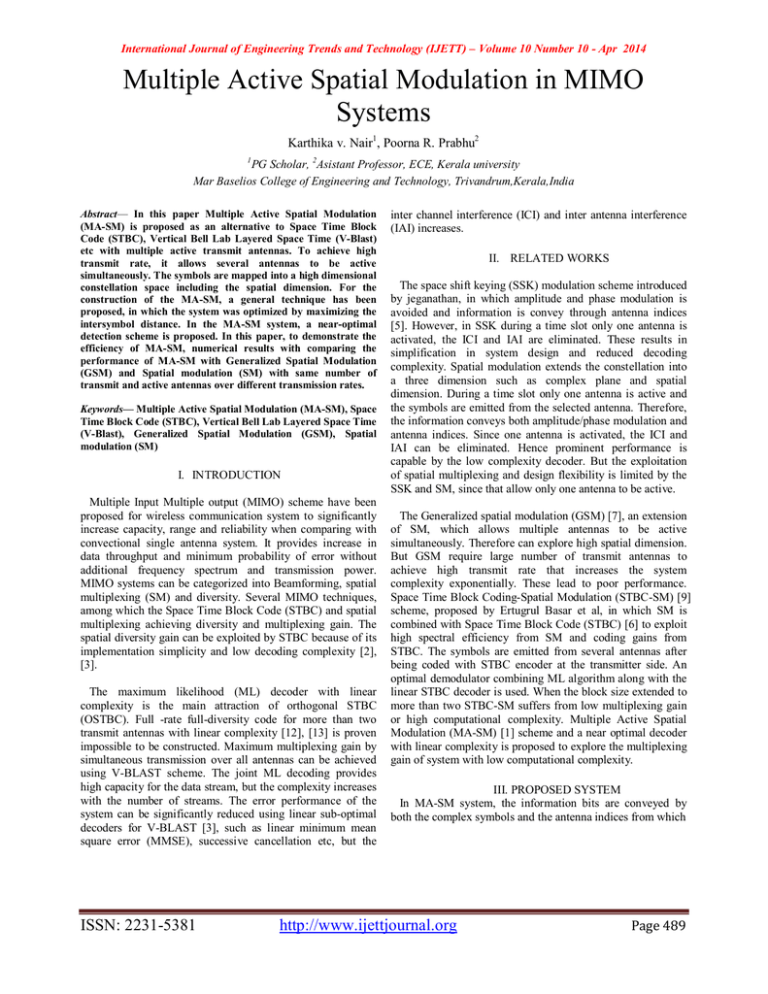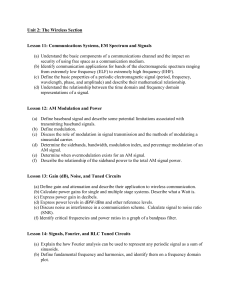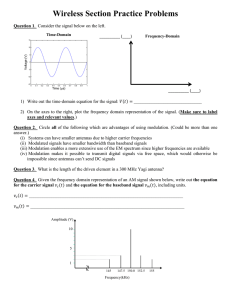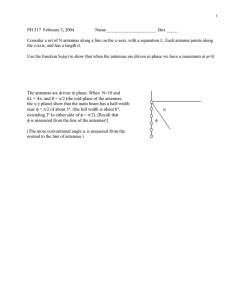Multiple Active Spatial Modulation in MIMO Systems Karthika v. Nair
advertisement

International Journal of Engineering Trends and Technology (IJETT) – Volume 10 Number 10 - Apr 2014 Multiple Active Spatial Modulation in MIMO Systems Karthika v. Nair1, Poorna R. Prabhu2 1 PG Scholar, 2Asistant Professor, ECE, Kerala university Mar Baselios College of Engineering and Technology, Trivandrum,Kerala,India Abstract— In this paper Multiple Active Spatial Modulation (MA-SM) is proposed as an alternative to Space Time Block Code (STBC), Vertical Bell Lab Layered Space Time (V-Blast) etc with multiple active transmit antennas. To achieve high transmit rate, it allows several antennas to be active simultaneously. The symbols are mapped into a high dimensional constellation space including the spatial dimension. For the construction of the MA-SM, a general technique has been proposed, in which the system was optimized by maximizing the intersymbol distance. In the MA-SM system, a near-optimal detection scheme is proposed. In this paper, to demonstrate the efficiency of MA-SM, numerical results with comparing the performance of MA-SM with Generalized Spatial Modulation (GSM) and Spatial modulation (SM) with same number of transmit and active antennas over different transmission rates. Keywords— Multiple Active Spatial Modulation (MA-SM), Space Time Block Code (STBC), Vertical Bell Lab Layered Space Time (V-Blast), Generalized Spatial Modulation (GSM), Spatial modulation (SM) I. INTRODUCTION Multiple Input Multiple output (MIMO) scheme have been proposed for wireless communication system to significantly increase capacity, range and reliability when comparing with convectional single antenna system. It provides increase in data throughput and minimum probability of error without additional frequency spectrum and transmission power. MIMO systems can be categorized into Beamforming, spatial multiplexing (SM) and diversity. Several MIMO techniques, among which the Space Time Block Code (STBC) and spatial multiplexing achieving diversity and multiplexing gain. The spatial diversity gain can be exploited by STBC because of its implementation simplicity and low decoding complexity [2], [3]. The maximum likelihood (ML) decoder with linear complexity is the main attraction of orthogonal STBC (OSTBC). Full -rate full-diversity code for more than two transmit antennas with linear complexity [12], [13] is proven impossible to be constructed. Maximum multiplexing gain by simultaneous transmission over all antennas can be achieved using V-BLAST scheme. The joint ML decoding provides high capacity for the data stream, but the complexity increases with the number of streams. The error performance of the system can be significantly reduced using linear sub-optimal decoders for V-BLAST [3], such as linear minimum mean square error (MMSE), successive cancellation etc, but the ISSN: 2231-5381 inter channel interference (ICI) and inter antenna interference (IAI) increases. II. RELATED WORKS The space shift keying (SSK) modulation scheme introduced by jeganathan, in which amplitude and phase modulation is avoided and information is convey through antenna indices [5]. However, in SSK during a time slot only one antenna is activated, the ICI and IAI are eliminated. These results in simplification in system design and reduced decoding complexity. Spatial modulation extends the constellation into a three dimension such as complex plane and spatial dimension. During a time slot only one antenna is active and the symbols are emitted from the selected antenna. Therefore, the information conveys both amplitude/phase modulation and antenna indices. Since one antenna is activated, the ICI and IAI can be eliminated. Hence prominent performance is capable by the low complexity decoder. But the exploitation of spatial multiplexing and design flexibility is limited by the SSK and SM, since that allow only one antenna to be active. The Generalized spatial modulation (GSM) [7], an extension of SM, which allows multiple antennas to be active simultaneously. Therefore can explore high spatial dimension. But GSM require large number of transmit antennas to achieve high transmit rate that increases the system complexity exponentially. These lead to poor performance. Space Time Block Coding-Spatial Modulation (STBC-SM) [9] scheme, proposed by Ertugrul Basar et al, in which SM is combined with Space Time Block Code (STBC) [6] to exploit high spectral efficiency from SM and coding gains from STBC. The symbols are emitted from several antennas after being coded with STBC encoder at the transmitter side. An optimal demodulator combining ML algorithm along with the linear STBC decoder is used. When the block size extended to more than two STBC-SM suffers from low multiplexing gain or high computational complexity. Multiple Active Spatial Modulation (MA-SM) [1] scheme and a near optimal decoder with linear complexity is proposed to explore the multiplexing gain of system with low computational complexity. III. PROPOSED SYSTEM In MA-SM system, the information bits are conveyed by both the complex symbols and the antenna indices from which http://www.ijettjournal.org Page 489 International Journal of Engineering Trends and Technology (IJETT) – Volume 10 Number 10 - Apr 2014 In this paper, the symbols are transmitted at a rate of 6 Bits/s/Hz and 15 Bits/s/Hz. For the transmission of 6 Bits/s/Hz, we are assuming four transmit antennas. From which two antennas are selected for transmission to avoid interference. Here two symbols are transmitted. For the transmission of 15 Bits/s/Hz, we are assuming five transmit antennas. From which three antennas are activated for the transmission to avoid interference. Here three symbols are transmitted for better transmission. The transmission scheme can be optimized, by maximizing the minimum distance between the codewords that dominates the BEP (Bit Error Probability) [1], [10]. Also for the system optimization, the active antenna group is selected, in such a way that the interference must be minimized. Fig 1. System model [1] those symbols are transmitted. In the system, consist of Nt transmit antennas and Nr receive antennas. From Nt transmit antennas, Np antennas are activated to carry the source information bits, which results in increase in multiplexing gain. Then the symbols undergo spatial modulation, in which the extension of two dimensional signal constellation such as M-PSK or M-QAM to a third dimension such as spatial dimension [12]. The symbol is transmitted through the channel; here the channel is Rayleigh fading channel, after being mapped through an M-QAM (M- Quadrature Amplitude Modulation). Here during the transmission, the signals are in serial form, it will be converted to parallel form, therefore a bulk of data can be transmitted at a time and transmitted through the channel. In reception side the reverse operation such as demodulation take place. The parallel symbols get converted back to serial form. The signals from the multiple diversity branches can be combined using various techniques [8]. In MRC, a weight factor that is proportional to the signal amplitude is multiplied to each signal branches. The branch with strong signal are further amplified and decoded, while the weak signal is attenuated. Since the signals are transmitted through multiple antennas, the spatial multiplexing gain and diversity gain is achieved by this system. B. Receiver In the receiver side, the parallel symbols transmitted through the channel are converted to serial form. The receiver will detect both the symbols and the active antenna indices. Here the receiver knows the knowledge of Channel State Information (CSI). The Maximal Ratio Combining (MRC) will detect the signal from the diversity branches. From each pair of transmit and receive antennas, the signal with maximum Signal to Noise ratio (SNR) is detected. After that the symbols undergo spatial demodulation. As Np varies optimal Maximum Likelihood decoding, increases the complexity exponentially. Therefore to overcome this, we use syndrome decoding. It is one of the most efficient methods to decode a signal from a noisy channel. The syndrome decoding takes the advantage of minimum distance decoding. It will minimize the hamming distance [13]. The hamming distance is denoted as, it is the numbers of coefficients in which they are differ. The receiver first decodes the antenna groups that transmit the symbols. The working of MA-SM receiver as follows: 1. 2. 3. A. Transmitter The working of MA-SM transmitter as follows: 1. 2. Every Np antennas out of Nt antennas are selected as active antennas. Denote the possible antenna groups as A. 3. Bits sequence of length 4. 5. 6. is transmitted through the Np antennas [ 8], [10]. The information bits are divided into Np+1 streams in which Np are mapped into QAM symbols selected from M-QAM symbols and the other one for antenna group detection. The rotation angle θ of signal vectors is determined for each X, so that more diversity gain can be achieved. The mapped Np symbols are transmitted the Rayleigh faded channel. ISSN: 2231-5381 4. 5. 6. Here we are assuming five receive antennas. The symbols that are received undergo M- QAM demodulation. Using the Maximal Ratio combining technique, the signal is detected from the diversity branches having highest SNR. The receiver knows the knowledge about channel State Information. The syndrome decoding will detect the symbol with minimum hamming distance. Therefore the original signal can be detected for a rate of 6Bits/s/Hz and 15Bits/s/Hz. The main errors occur at the receiver is due to the error in detection of active antennas and the second error is due to signal demapping. These two errors are mainly constituted in Bit Error Probability (BEP). These errors can be avoided by the proper detection of active antennas from the signal space and the proper detection of signals using the syndrome decoding technique. http://www.ijettjournal.org Page 490 International Journal of Engineering Trends and Technology (IJETT) – Volume 10 Number 10 - Apr 2014 IV. NUMERICAL RESULTS It is necessary to compare the performance of MA-SM with GSM and SM with same number of transmit and active antennas over different transmission rates. Figure 3 and figure 4 gave the performance of MA-SM and GSM with same Ґ for transmission rates 6Bit/s/Hz and 15Bit/s/Hz. The Ґ’s employed here include Ґ= (4,2), (5,3), (6,3), (7,2), (8,2), which are typical parameter sets introduced in [6]. Assuming five receive antennas for each case. V. CONCLUSION Multiple Active Spatial modulation (MA-SM) is introduced in this paper, as an alternative to existing techniques, such as GSM, SM etc. For the construction of the MA-SM, a general technique has been proposed, in which the system was optimized by maximizing the intersymbol distance. On comparing the performance of MA-SM with GSM and SM at 6Bits/s/Hz and 15Bits/s/Hz, the MA-SM produced better performance. It can be concluded that the MA-SM produce better performance over different transmission rates. ACKNOWLEDGMENT We wish to express our deep gratitude towards the almighty for giving us strength to work and coming up with this research paper. We are grateful to the Professors of MBCET and our families for giving the inspiration and motivation for completing this work. We are also thankful to my entire colleague’s for their everlasting moral support and encouragements. REFERENCES Fig 3. Comparing between MA-SM and GSM scheme at 6Bits/s/Hz Fig 4. Comparing between MA-SM and GSM scheme at 15Bits/s/Hz In MA-SM, under the rate of 6/Bit/s/Hz the best Ґ= (4, 2) with better transmission without channel interference. The performance degradation of Ґ = (4, 3) is caused by the channel interference introduced by adjacent transmission. In 15Bit/s/Hz, the best Ґ = (5, 3) without channel interference and the performance degradation of Ґ = (6,3) caused by channel interference introduced by adjacent transmission. ISSN: 2231-5381 [1] Jintao Wang, Shuyun Jia, and Jian Song, “Generalised Spatial Modulation System with Multiple Active Transmit Antennas and Low Complexity Detection Scheme” IEEE Transactions on Wireless Communications, vol. 11, no. 4, April 2012. [2] H. Jafarkhani, Space-Time Coding, Theory and Practive. Cambridge University Press, 2005. [3] P. Wolniansky, G. Foschini, G. Golden, and R. Valenzuela, “V-blast: an architecture for realizing very high data rates over the rich-scattering wireless channel,” in Proc. 1998 International Symp. Signals, Syst., Electron., pp. 295–300. [4] V. Tarokh, H. Jafarkhani, and A. R. Calderbank, “Space-time block codes from orthogonal designs,” IEEE Trans. Inf. Theory, vol. 45, no. 5, pp. 1456–1467, July 1999. [5] J. Jeganathan, A. Ghrayeb, L. Szczecinski, and A. Ceron, “Space shift keying modulation for MIMO channels,” IEEE Trans. Wireless Commun., vol. 12, pp. 3692–3703, July 2009. [6] R. Mesleh, H. Haas, S. Sinaovic, C. W. Ahn, and S. Yun, “Spatial modulation,” IEEE Trans. Veh. Technol., vol. 57, no. 4, pp. 2228–2241, July 2008. [7] A. Younis, N. Serafimovski, R. Mesleh, and H. Haas, “Generalised spatial modulation,” in Proc. 2010 Signals, Syst. Comput., pp. 1498– 1502. [8] J. Fu, C. Hou, W. Xiang, L. Yan, and Y. Hou, “Generalisted spatialmodulation with multiple active transmit antennas,” in Proc. 2010 IEEE Globecom Workshops, pp. 839–844. [9] E. Ba¸sar, Ümit Aygölü, E. Panayici, and H. V. Poor, “Space-time block coded spatial modulation,” IEEE Trans. Commun., vol. 59, pp. 823– 832, Mar. 2010. [10] Aparna S, Nithin S S, Parameshachari B D, Muruganatham C, Prof. H S Divakara Murthy “Low Complexity Multiple Active Transmit Antenna For High Transmit Rate” IJCSMC, Vol. 2, Issue. 8, August 2013, pg.33 – 46. [11] E. Basar and Ümit Aygölü, “High-rate full-diversity space-time block codes for three and four transmit antennas,” IET Commun., vol. 3, no. 8, pp. 1371–1378, Aug. 2009. [12] R. Mesleh, H. Haas, C. W. Ahn, and S. Yun, “Spatial modulation a new low complexity spectral efficiency enhancing technique,” in 2006 Commun. Netw. China, pp. 1–5. [13] E. Ba¸sar and Ümit Aygölü, “High-rate full-diveristy space-time block codes for three and four transmit antennas,” IET Commun., vol. 3, no. 8, pp. 1371–1378, Aug. 2009. [14] ——, “Full-rate full-diversity STBCS for three and four transmit antenns,” Electron. Lett., vol. 44, no. 18, pp. 1076–1077, Aug. 2008. http://www.ijettjournal.org Page 491



![EEE 443 Antennas for Wireless Communications (3) [S]](http://s3.studylib.net/store/data/008888255_1-6e942a081653d05c33fa53deefb4441a-300x300.png)
